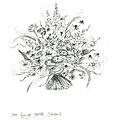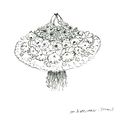Bunch of flowers
A bouquet is a bouquet of flowers with a binding point. So it can be easily transported. Flower bouquet is also used synonymously.
Cultural history
Aside from their medicinal use, flowers were first used as ornamental containers for sacrificial and grave goods. The Egyptians, later the Greeks and the Romans, used flowers for their customs. In Egypt there are grave goods from around 1540 BC. Around BC, which consisted of the representation of red poppies , yellow macaws, cornflowers and lilies . In ancient Greece it was already common practice to give flowers and blossoms to young women as gifts to praise feminine beauty. In northern Europe it was part of the Germanic customs that young girls and women adorn themselves with wreaths of fresh flowers on festive occasions, for example at weddings or on high holidays and fertility festivals.
In the course of the Christianization of Europe, the flower arrangement and with it the bouquet initially lost its importance. Meanwhile, the art of flower-making was highly valued in other cultures: In Japan, the meditative art of Ikebana has been practiced since the 6th century AD and has been shown to have been part of the training of young nobles since the 15th century at the latest. In contrast to the purely decorative bouquets of the western world, ikebana bouquets are supposed to express an inner harmony and a higher principle of order.
In Europe, the ancient custom of giving flowers as gifts only regained importance with the Renaissance . The bouquet of flowers as a transient gift hit the zeitgeist, especially during the Baroque , which praised the transient and the otherworldly. Initially reserved primarily for the aristocracy, the bouquet of flowers came into fashion among the bourgeoisie from the beginning to the middle of the 19th century. It was only during this time that the bouquet developed as an independent, deliberately designed form. Towards the end of this century, the private sector of the house gained in importance due to the industrial boom and the resulting richer bourgeoisie. The bouquet of flowers became an integral part of the living environment of the bourgeoisie.
Horticulture was no longer a purely aristocratic affair, and private firms established themselves. Art and commercial nurseries began to market their products to the rapidly growing group of buyers.
Franz Kolbrand wrote in his first edition floristry book Europa winds den Kranz : “In the change of worldviews from the mystical Middle Ages to the sensual Renaissance, then to the exuberant exuberance of the Baroque and the delicate elegance of the Rococo to Impressionism and Expressionism probably the extent and vehemence of the "loose abundance" of bouquets, but always the natural essence of lively greenery and blooming remains the real meaning of all performance. "
The natural essence of flowers is an important part of Weihenstephan's design, which is taught at the State Technical School for Flower Art in Weihenstephan .
use
- The earliest recorded use of fresh flowers is as grave goods and ornaments.
- In ancient times and in antiquity, women adorned themselves with wreaths of flowers for special festivities.
- The bridal bouquet has been known since the Renaissance ; Originally the strongly fragrant flowers served the practical purpose of covering body odors and the heavy scent of incense; Today, bouquets of flowers are worn by women on numerous festive occasions such as weddings, communion or confirmation, prom etc.
- The custom of presenting a lapel bouquet to a woman at an invitation to a ball dates back to Victorian times.
- The bouquet has been popular as a gift since the baroque era up to the present day.
- The bouquet has been used for decorative purposes since the end of the 19th century and has been decorating interiors ever since.
Flower binding is now called floristry (handicraft) and goes back to various traditional and cultural developments. The bouquet is a socially established symbol with various meanings.
Depending on the occasion, bouquets of flowers have different shapes and colors. For example, colorful bouquets are given away for recovery to cheer up a sick person and convey vitality, while in funeral floristry, dignified colors express sympathy and sadness.
A bouquet of flowers can make a statement as a whole. A bow tied to the right means that the message of the bouquet applies to the recipient, while a bouquet of flowers that is held together with a bow tied to the left makes a statement about the giver himself.
Bouquet shapes
Variants of the binding technique
- Tied in a spiral
- Tied in parallel
Bouquet
For the bouquet, the flowers are tied head to head. The cuff is made of sheets or paper. But it can also consist of fine, twisted willow branches. The flowers themselves are wired, depending on the variety with a certain technique. For example, roses are shortened to 3 to 4 cm stem length, then usually wrapped with wet cotton wool. The stem is then artificially lengthened again using pintle wire so that the flowers can be bound. The so-called "padding" is supposed to ensure longer freshness. The cotton wool and the wire are then wrapped with a special adhesive tape. This flora tape becomes very sticky due to the slight pull exerted by the florist and ensures that the wire handles do not slip.
When tying, attention is paid to an even dome shape, which must not appear too pointed but also not too flat. This shape ends with a right-angled end to the stem. The stem itself is then usually shortened to the width of a hand plus 2 cm, then tightly wrapped again with flora tape. A thin layer of wadding makes it more comfortable to hold. A silk ribbon in the right color, which is tied evenly around the handle, completes the workpiece.
Long handled bindery
The long-handled binding, which is sometimes also referred to as the “German natural bouquet”, has been a common form of binding since the 1950s. The flower stems are tied long and are therefore part of the design. This results in the natural essence of the flower being expressed. Due to the long stems, which can absorb water so well, the long-stemmed binding enables the flowers to last longer.
Bouquet of Mary
The bouquet of Mary generally only consists of four different flowers. These usually have different colors. The binding of flowers to a bouquet of the Virgin Mary used to be widespread as altar decorations .
Floral language
Since the 18th century, flowers have been used not only as decorative ornament but also as a means of communication. The different flowers and their combination convey messages. The " language of flowers " was first described by Lady Mary Wortley Montagu, who collected the different meanings of flowers on her travels. The code consists of the type of flower, its color, its age (as a bud or fully bloomed) and the composition of the flowers. A single bouquet can thus convey a complex message.
See also
literature
- Tergit, Gabriele (1963): Imperial Crowns and Red Peonies: A Brief Cultural History of Flowers . Knaur Verlag 1963.
Web links
Individual evidence
- ↑ Review: "The Flower in Cultural History", lecture by LA Adelheid Schönborn ( Memento from March 4, 2016 in the Internet Archive )
- ↑ http://www.blumen-online-ratgeber.de/brauchum_blumenhaben.htm
- ↑ http://www.ikebana-berlin.de/
- ↑ http://www.blumen-online-ratgeber.de/brauchum_blumenhaben.htm
- ↑ Say it through the flower! ( Memento from March 12, 2014 in the Internet Archive )






